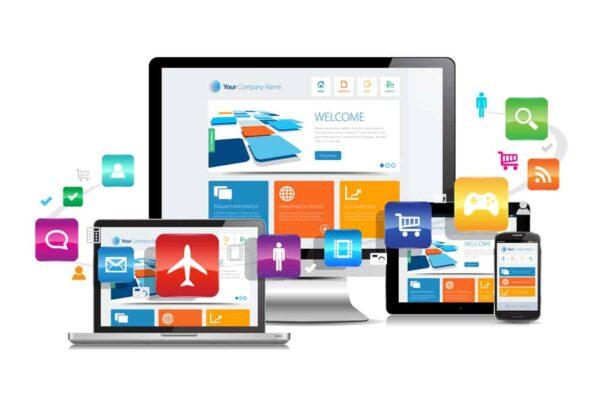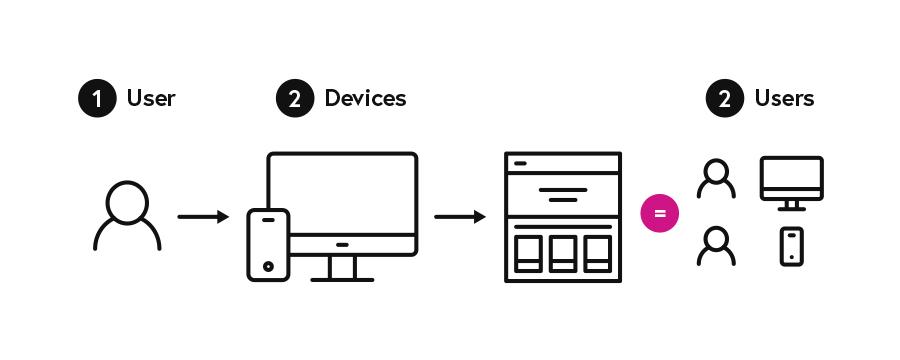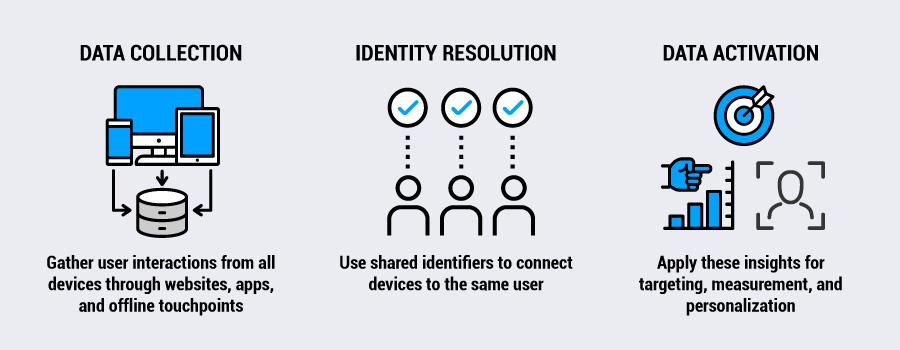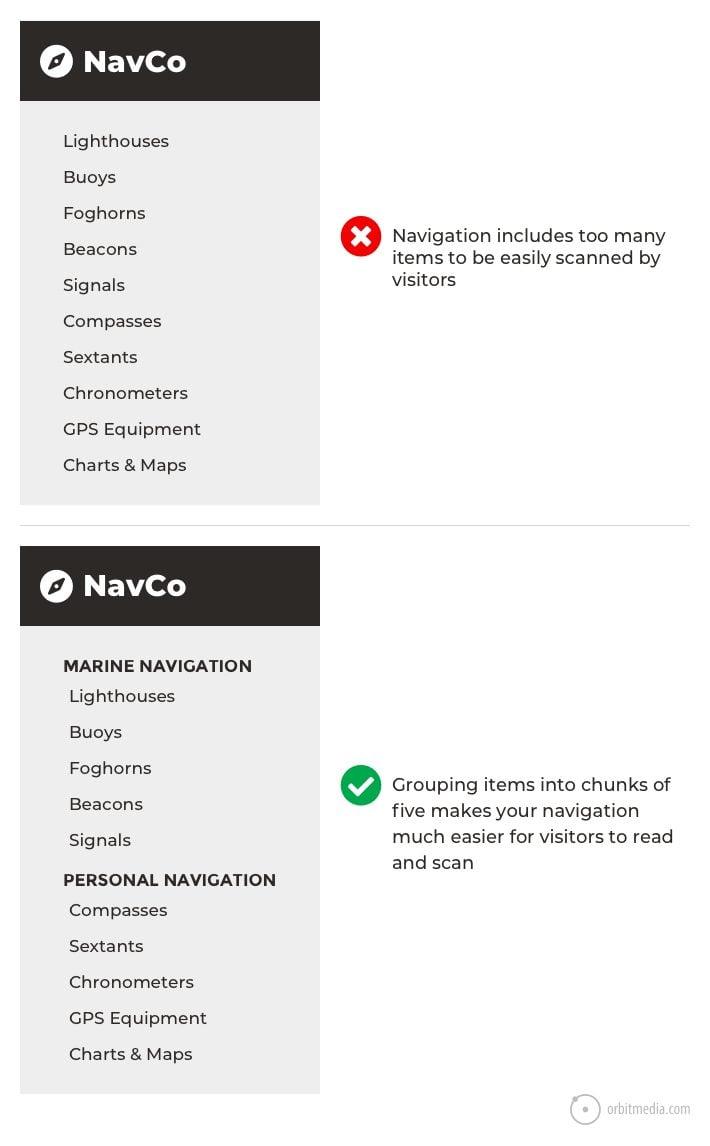In today’s fast-paced digital landscape, understanding your customer’s journey is more crucial than ever. But with consumers hopping between devices—from smartphones to tablets to laptops—grasping the full picture can feel like piecing together a jigsaw puzzle without knowing what the final image looks like.Enter cross-device tracking, a game-changing tool that not only enhances how we analyze customer interactions but also transforms the way businesses approach their marketing strategies. Imagine having the ability to follow your customers seamlessly as thay browse, shop, and engage, nonetheless of the device they’re using.This isn’t just a tech trend; it’s the key to unlocking deeper insights into customer behavior and preferences. In this article, we’ll dive into how cross-device tracking can elevate your customer journey analysis, providing you with the data-driven insights needed to craft more personalized experiences that resonate with your audience.Let’s explore how harnessing this powerful tool can lead to smarter decisions and, ultimately, happier customers!
Understanding the Importance of Cross-Device Tracking in Modern Marketing
In today’s digital landscape,consumers seamlessly transition between devices—from smartphones to tablets to desktops. This shift has made it crucial for marketers to understand how their audiences engage across multiple platforms. Cross-device tracking offers a complete view of consumer behavior, allowing businesses to tailor their strategies and enhance the customer journey more effectively.
by implementing cross-device tracking, marketers can:
- Identify User Behavior: Gain insights into how customers interact with your brand across various devices, leading to a more personalized experience.
- Optimize Campaigns: Pinpoint which devices are driving the most conversions and allocate resources efficiently to maximize ROI.
- Enhance User Experience: Deliver consistent messaging and tailored content, ensuring that customers receive relevant information regardless of the device they use.
Moreover, understanding the customer journey becomes much clearer when you can track interactions across devices. For instance, a user might discover your product on their mobile phone while commuting but later finalize the purchase on a laptop. Without cross-device capabilities, these touchpoints might remain isolated, leading to incomplete data and missed opportunities.
| Device | Common Actions | Marketing Strategy |
|---|---|---|
| Mobile | Browsing, Research | Mobile-optimized ads |
| Tablet | Comparison | Visual content promotion |
| desktop | Purchasing, Reviews | Email follow-ups |
Ultimately, cross-device tracking is not just a technical necessity; it’s a strategic advantage.by connecting the dots in the customer journey, brands can foster loyalty and drive sales in an increasingly fragmented digital environment. as we move forward, companies that embrace this holistic view of consumer behavior will likely stand out in a competitive marketplace.
How Cross-Device Tracking Creates a Seamless Customer Experience
In today’s digital landscape, understanding the customer journey is more crucial than ever. Cross-device tracking allows businesses to gather insights across various platforms, creating a cohesive and engaging experience for users. Imagine a customer starting their day by checking their email on a smartphone, later browsing products on a tablet, and finally making a purchase on a desktop. With effective tracking,brands can connect these dots seamlessly.
One of the most notable advantages of cross-device tracking is the ability to deliver personalized marketing messages. By understanding how customers interact with different devices,businesses can tailor their communications to match user behavior. Here are some strategies that can enhance personalization:
- Targeted Ads: Show relevant ads based on previous interactions across devices.
- Dynamic Content: Adjust website content to reflect user preferences and history.
- Email Campaigns: Send reminders or recommendations based on cross-device activity.
moreover,cross-device tracking paves the way for comprehensive data analysis. Businesses can identify not only which devices are most popular among their audience but also how these devices influence purchasing decisions. This can be illustrated in a simple table:
| Device Type | Average Time Spent | Conversion Rate |
|---|---|---|
| Smartphone | 3 hours | 30% |
| Tablet | 2 hours | 25% |
| Desktop | 4 hours | 35% |
This data helps in optimizing marketing strategies. By recognizing trends and user preferences,brands can make informed decisions that enhance customer satisfaction. Additionally, understanding device-specific behaviors can lead to improvements in user experience, ensuring that each interaction is as smooth as possible.
Ultimately, cross-device tracking is not just about collecting data; it’s about leveraging that data to create meaningful interactions. By understanding the entire customer journey, businesses can foster loyalty and drive long-term engagement. Embracing this approach not only enriches the user experience but also provides a competitive edge in today’s fast-paced market.

the Role of Data Integration in Comprehensive Journey Mapping
In today’s digital ecosystem, understanding the customer journey is more crucial than ever. Data integration plays a pivotal role in this process, by consolidating information from various touchpoints and channels. When businesses embrace a holistic view of customer interactions,they can create a seamless experience that resonates with users.
Here are some key aspects of how data integration enhances the mapping of customer journeys:
- Unified Data Sources: By pulling data from multiple platforms—be it social media, email campaigns, or in-store interactions—companies can paint a clearer picture of the customer experience.
- Real-Time Insights: Integrated data allows businesses to analyze customer behaviors in real-time, enabling them to adapt strategies on-the-fly and respond to emerging trends quickly.
- Enhanced Personalization: With a comprehensive view of customer data, brands can tailor their offerings and communications to meet individual preferences, increasing engagement and loyalty.
Moreover, effective data integration helps identify gaps in the customer journey. By analyzing touchpoints where customers drop off, businesses can pinpoint specific areas for advancement. This allows for a more targeted approach to optimize the journey, ultimately leading to higher conversion rates.
as organizations collect vast amounts of data, it’s vital to use the right tools and technologies for integration. The following table outlines popular data integration tools that can be leveraged for effective journey mapping:
| tool Name | Key Features | Best For |
|---|---|---|
| Zapier | Easy automation and integrations | Small to medium businesses |
| MuleSoft | Scalable integrations and APIs | large enterprises |
| Segment | Customer data platform | Data-driven marketing |
Ultimately, the power of integrated data lies in its ability to transform fragmented customer insights into actionable strategies. By prioritizing data integration, businesses can not only enhance their understanding of the customer journey but also create meaningful experiences that foster long-term relationships.
Identifying key Touchpoints Across Devices for Better Insights
In today’s digital landscape, understanding the customer journey requires a multifaceted approach that spans across various devices. By identifying key touchpoints, businesses can gather invaluable insights that illuminate the path a customer takes from awareness to conversion. These touchpoints frequently enough include interactions on smartphones, tablets, desktops, and even smart TVs. Each device plays a unique role in shaping customer perceptions and decisions.
To effectively track and analyze these interactions, consider the following key touchpoints:
- Website Visits: Customers might start their journey on a mobile device, searching for information before transitioning to a desktop for a deeper dive.
- Social Media Engagement: Scrolling through feeds on a smartphone can lead to conversations or actions taken later on a tablet or PC.
- Emails: Promotional emails opened on a mobile device could prompt visits to a website on a larger screen for purchase.
- In-app Actions: Interactions within apps on smartphones can guide users to explore similar products on desktops.
Understanding these touchpoints not only enhances the customer experience but also allows businesses to optimize their marketing strategies. As an example, by analyzing data from each device, marketers can identify which platforms drive the most conversions and tailor their content accordingly. A study of customer behavior across devices can reveal patterns that inform future campaigns, ensuring they resonate with the target audience.
| device | Primary Touchpoint | Customer Action |
|---|---|---|
| Smartphone | Social Media | Engagement with ads |
| Tablet | Web Browsing | Product Research |
| Desktop | email Campaigns | Purchasing |
| Smart TV | Streaming Ads | Brand Awareness |
By employing cross-device tracking, businesses can connect the dots between these interactions, leading to a more cohesive understanding of the customer journey. This holistic view enables companies to not only address pain points but also to celebrate successes in their marketing efforts.The ultimate goal is to create a seamless experience that keeps customers engaged, regardless of how they choose to interact with your brand.

Personalization Powered by Cross-Device Data: A Game Changer
in today’s digital landscape, consumers engage with brands across multiple devices—smartphones, tablets, laptops, and even smart TVs. This dynamic behavior presents a unique prospect for businesses to create a more personalized experience for their customers. By capturing data across these devices,brands can gain a holistic view of the customer journey,enabling them to tailor their strategies effectively.
here are several ways that leveraging cross-device data revolutionizes customer interaction:
- Seamless experience: By understanding how users transition from one device to another, brands can ensure a consistent experience that meets customer expectations at every touchpoint.
- Enhanced Targeting: Cross-device insights allow for more precise targeting, making sure that the right message reaches the right audience at the right time.
- Informed Decision Making: Data analytics can reveal patterns in user behavior, assisting marketers in optimizing campaigns and improving overall performance.
Cross-device tracking also enables businesses to pinpoint the specific moments that influence purchasing decisions. For instance,a user might browse products on their smartphone during lunch,then switch to their laptop in the evening to finalize a purchase. By capturing these interactions,marketers can craft tailored follow-up messages that resonate with the user’s journey. This encourages conversions and fosters brand loyalty.
| Device | Common Uses | Data Insights |
|---|---|---|
| Smartphone | Browsing,Social Media | Initial interest,Engagement metrics |
| Tablet | Research,Informational | Content consumption patterns |
| laptop | Purchasing,Detailed Research | Final decision indicators |
Moreover,personalization powered by cross-device data doesn’t just drive sales; it also contributes to building meaningful relationships. Customers who feel understood are more likely to remain loyal to a brand. By using insights from their multi-device behavior, companies can create targeted loyalty programs, personalized recommendations, and engaging content that speaks directly to individual needs and preferences.

Best Practices for Implementing Cross-device Tracking Strategies
Implementing effective cross-device tracking strategies is crucial for understanding the customer journey in today’s multi-device world. Here are some best practices to ensure your tracking methods are both efficient and compliant:
- Utilize Unique Identifiers: Leverage unique identifiers like email addresses or user IDs to create a consistent profile across devices. This method enhances the accuracy of your tracking and helps build a more comprehensive view of user interactions.
- employ First-Party Data: Focus on collecting first-party data through your own platforms. This not only ensures better accuracy but also helps maintain compliance with data privacy regulations.
- integrate analytics Tools: Use advanced analytics tools that support cross-device tracking. Platforms like Google Analytics 4 and Adobe Analytics offer features specifically designed to track user behavior across multiple devices seamlessly.
- Implement Tag Management Systems: Tag Management Systems (TMS) allow you to manage and deploy tags across your site efficiently. They can definitely help you maintain association and consistency in your tracking efforts.
- Regularly Test and Optimize: Continuously test your tracking setup to identify gaps or inaccuracies. use A/B testing and user feedback to refine your strategies and ensure you’re capturing the full customer journey.
| Strategy | Benefit |
|---|---|
| Unique Identifiers | Improved accuracy in user profiles |
| First-Party Data | better compliance and reliability |
| Analytics Tools | Seamless cross-device tracking |
| Tag Management Systems | Efficient tag deployment |
| Testing and Optimization | Enhanced tracking performance |
By following these best practices, you can develop a robust cross-device tracking strategy that not only enhances your understanding of the customer journey but also drives actionable insights. Remember, the goal is to create a seamless and personalized experience for your users, allowing you to engage them effectively across all touchpoints.

Overcoming Privacy Concerns: Building Trust with Customers
In today’s digital landscape, where consumers are becoming increasingly aware of their privacy rights, businesses must prioritize transparency and security to foster trust. Cross-device tracking, when implemented thoughtfully, can serve as a powerful tool for enhancing customer journey analysis while also addressing privacy concerns head-on. By understanding how customers interact across multiple devices, businesses can create personalized experiences that resonate deeply with their audience.
Here are some key strategies to mitigate privacy concerns while leveraging cross-device tracking:
- Clear Interaction: Inform customers about the data being collected and how it will be used. Transparency breeds trust.
- Opt-In Consent: Allow customers to opt-in to tracking features, giving them control over their data.
- Data Minimization: Collect only the data necessary for analysis, ensuring that customer information remains secure and relevant.
- Regular Audits: Conduct regular audits of data practices to ensure compliance with privacy regulations such as GDPR and CCPA.
By embracing these strategies, businesses can demonstrate a commitment to ethical data practices. This not only enhances the customer experience but also establishes a foundation of trust. When customers feel secure about their data, they are more likely to engage with brands and share valuable insights, ultimately enriching the customer journey analysis.
To illustrate the effectiveness of cross-device tracking while respecting privacy, consider the following table that showcases the potential benefits versus perceived risks:
| Benefits | Perceived Risks |
|---|---|
| Enhanced personalization of marketing strategies | Data misuse or breaches |
| Improved customer engagement through targeted content | Loss of anonymity |
| Comprehensive understanding of customer preferences | Overcollection of data |
ultimately, the goal is to strike a balance where cross-device tracking serves as a benefit rather than a hindrance. By prioritizing customer privacy while effectively utilizing data, businesses can turn privacy concerns into opportunities for deeper connections. With every step towards transparency, organizations can enhance customer journey analysis, ultimately leading to more loyal and trusting customer relationships.

Tools and Technologies to Enhance Your Cross-Device Tracking Efforts
To effectively enhance your cross-device tracking efforts, leveraging the right tools and technologies is paramount.A combination of analytics platforms, user identification solutions, and data management systems can substantially improve your understanding of customer interactions across various devices.
Analytics Platforms: Advanced analytics platforms like Google Analytics 4 and Adobe Analytics offer features that help you track user behavior across devices. These platforms provide insights into user journeys, allowing you to see how customers transition from mobile to desktop and vice versa.
User Identification Solutions: Solutions such as Segment and BlueCava focus on creating a unified profile for users, regardless of the device they are using. By implementing these technologies, businesses can gather extensive data on customer interactions, enabling personalized marketing strategies that resonate with users’ preferences.
Data Management Platforms (DMP): Utilizing DMPs like Lotame and Oracle BlueKai allows you to aggregate data from various sources, enriching your understanding of customer behavior across devices.these platforms help in audience segmentation and targeting, making your cross-device efforts more effective.
Additionally, integrating tools that offer cookie-less tracking options is essential as privacy regulations evolve. Solutions like Funnel.io and Tealium provide strategies for tracking without relying solely on cookies, ensuring you stay compliant while still gathering valuable user data.
| Tool/Technology | Key Feature |
|---|---|
| Google analytics 4 | Cross-device user tracking |
| Segment | Unified user profiles |
| Lotame | Data aggregation |
| Funnel.io | Cookie-less tracking |

Real-World Success Stories: Brands Thriving with Cross-Device Insights
In the competitive landscape of modern marketing,brands that harness the power of cross-device insights are seeing remarkable results. By capturing a holistic view of their customers’ interactions across devices, these companies are not just surviving; they are thriving. Let’s take a look at some real-world examples that illustrate the transformative impact of cross-device tracking.
1.Retail Revolution: A leading retail brand implemented a cross-device tracking strategy that connected their in-store and online experiences. By analyzing data from customers’ mobile apps, desktops, and physical store visits, they enhanced their marketing campaigns. The result? A 30% increase in conversions from online ads, thanks to personalized promotions that reached customers at the right moment, regardless of the device they were using.
2. Automotive Innovation: An automotive manufacturer leveraged cross-device insights to refine its customer journey analysis. By tracking potential buyers across platforms, they identified key touchpoints where prospects were dropping off in the sales funnel. With this information,they tailored their messaging and retargeted customers effectively,leading to a 25% boost in lead generation and a significant improvement in the overall customer experience.
3. Travel Change: A popular travel agency utilized cross-device tracking to understand how users interacted with their booking platform. By monitoring user behavior on mobile, tablets, and desktops, they devised an integrated marketing strategy that targeted customers with tailored content. This approach resulted in a 40% increase in bookings, as travelers received relevant offers based on their browsing habits across different devices.
| Brand | Cross-Device Strategy | Result |
|---|---|---|
| Retail Brand | Integrated in-store and online experiences | 30% increase in online conversions |
| Automotive Manufacturer | Identified drop-off points in sales funnel | 25% boost in lead generation |
| Travel Agency | Monitored user behavior across platforms | 40% increase in bookings |
The synergy created by cross-device tracking not only enhances customer journey analysis but also drives tangible results. brands that invest in understanding their customers’ behaviors across devices can tailor their marketing strategies to meet their audience where they are, ultimately leading to greater satisfaction and loyalty.
Future Trends in Cross-device Tracking and Customer Journey Analysis
The landscape of customer interaction is rapidly evolving, necessitating innovative approaches to understand how consumers engage with brands across myriad devices. As companies strive to deliver a seamless customer experience, the importance of cross-device tracking in customer journey analysis becomes paramount. This technique not only enables businesses to gather comprehensive insights but also fosters personalized marketing strategies that resonate with individual preferences.
Emerging technologies are set to transform how businesses approach tracking customer behavior.Artificial Intelligence (AI) and Machine Learning (ML) are leading the charge, providing enhanced capabilities to analyze vast datasets quickly. With AI-powered tools, companies can:
- Identify patterns in customer behavior across devices.
- Predict future interactions based on ancient data.
- Segment audiences more effectively for targeted marketing campaigns.
Moreover, the integration of IoT devices amplifies the cross-device tracking capabilities. From smart home assistants to wearable technology, these devices collect data that enriches the customer profile. This holistic view allows marketers to tailor communications at pivotal touchpoints in the customer journey. For example, a customer researching a product on their smartphone could receive personalized recommendations through their smart speaker while they cook dinner.
Data privacy remains a critical concern in this evolving landscape. As regulations like GDPR and CCPA come into play, businesses must navigate these waters carefully. Ethical data collection practices will not only enhance trust between consumers and brands but also improve the quality of insights gained. By ensuring transparency in how data is collected and used, brands can build stronger relationships with their customers, ultimately leading to increased loyalty.
As we look ahead, cross-device tracking will likely leverage new advancements in blockchain technology, which promise enhanced data security and consumer control over personal information. This shift will empower customers to engage more freely with brands, knowing their data is managed transparently and securely. The future of customer journey analysis lies in creating a balance between personalization and privacy, ensuring that consumers feel valued and understood without compromising their security.
Frequently Asked Questions (FAQ)
Q&A: How cross-Device Tracking Enhances Customer Journey Analysis
Q: What exactly is cross-device tracking?
A: Great question! Cross-device tracking is a method used to monitor user activity across multiple devices, such as smartphones, tablets, and desktops. It helps businesses understand how customers interact with their brand through different platforms. By linking these interactions, companies can create a comprehensive view of each customer’s journey.
Q: Why is understanding the customer journey so significant?
A: Understanding the customer journey is crucial because it allows businesses to see how customers engage with their brand at every touchpoint. This insight helps in identifying pain points, preferences, and behaviors, leading to better customer experiences. When you know how and when customers prefer to interact, you can tailor your marketing strategies more effectively.
Q: How does cross-device tracking improve this understanding?
A: Cross-device tracking enhances understanding by providing a holistic view of customer behavior. Without it, a customer may appear as separate entities on different devices.By tracking them seamlessly across devices, businesses can see the complete picture—from that initial ad click on a phone to making a purchase on a laptop. This continuity helps in making informed decisions about marketing, product offerings, and customer support.
Q: Can you give an example of how a business might use this data?
A: Absolutely! Imagine an online retailer that notices a customer browses products on their phone but doesn’t complete the purchase. Later, they receive an email promotion for those items. Thanks to cross-device tracking, the retailer knows which products to highlight, and they can even tailor messages based on the customer’s previous interactions.This personalized approach can significantly increase the chances of conversion!
Q: what are some challenges businesses face with cross-device tracking?
A: While cross-device tracking has many benefits, it does come with challenges. Privacy concerns are at the forefront—customers wont assurance that their data is secure. additionally, implementing effective tracking systems can require investment in technology and expertise. Though, the payoff in customer insights can far outweigh these challenges.
Q: How can businesses ensure they are using cross-device tracking ethically?
A: Ethical use starts with transparency. Businesses should inform customers about the data being collected and how it will be used. Providing options for opting out and ensuring data protection measures are in place builds trust.When customers feel secure, they’re more likely to engage with the brand.
Q: What’s the bottom line for businesses considering cross-device tracking?
A: The bottom line is that cross-device tracking can transform the way a business understands and engages with its customers.By leveraging this powerful tool, companies can create more personalized experiences, increase customer satisfaction, and ultimately drive sales.It’s not just about tracking; it’s about building a relationship with your customers across all their devices. Isn’t that worth considering?
In Summary
As we wrap up our exploration of cross-device tracking and its role in enhancing customer journey analysis, it’s clear that this powerful tool is more than just a tech trend—it’s a game-changer for businesses looking to understand their customers on a deeper level. By connecting the dots across various devices, companies can craft personalized experiences that resonate with users, ultimately leading to increased loyalty and conversions.
Imagine being able to understand your customer’s journey from the moment they first discover your brand on their phone, to the time they make a purchase on their laptop—all without missing a beat. With cross-device tracking, this vision becomes a reality, allowing businesses to tailor their marketing strategies like never before.
so, if you haven’t already embraced this innovative approach, now’s the perfect time to dive in. The insights you gain can not only enhance your understanding of customer behavior but also empower you to create strategies that truly engage and delight your audience. Let’s not just follow the journey—let’s lead it! By leveraging the full potential of cross-device tracking, you’re not just improving analytics; you’re investing in relationships that will pay off for years to come.
Ready to take your customer journey analysis to the next level? The future is here—let’s embrace it together!



